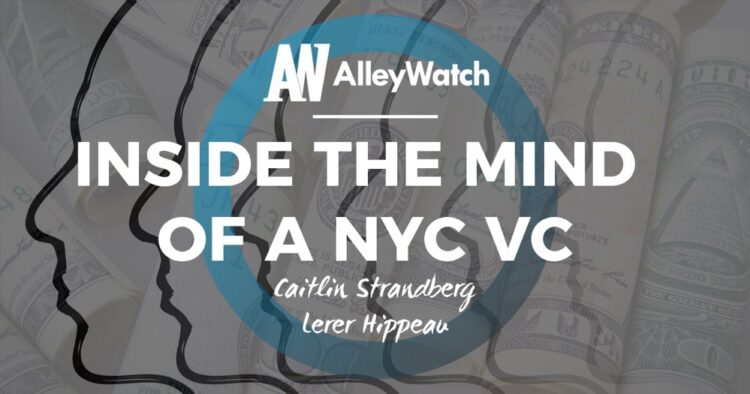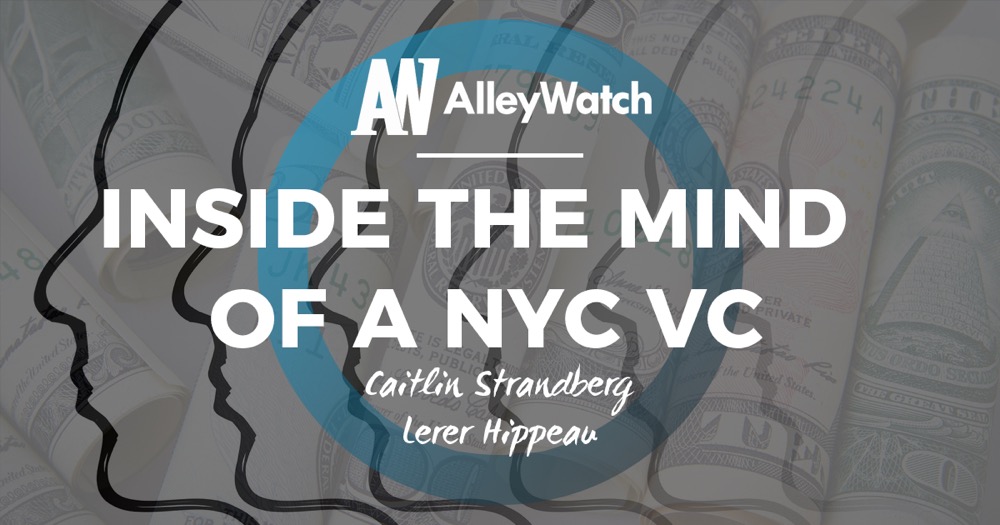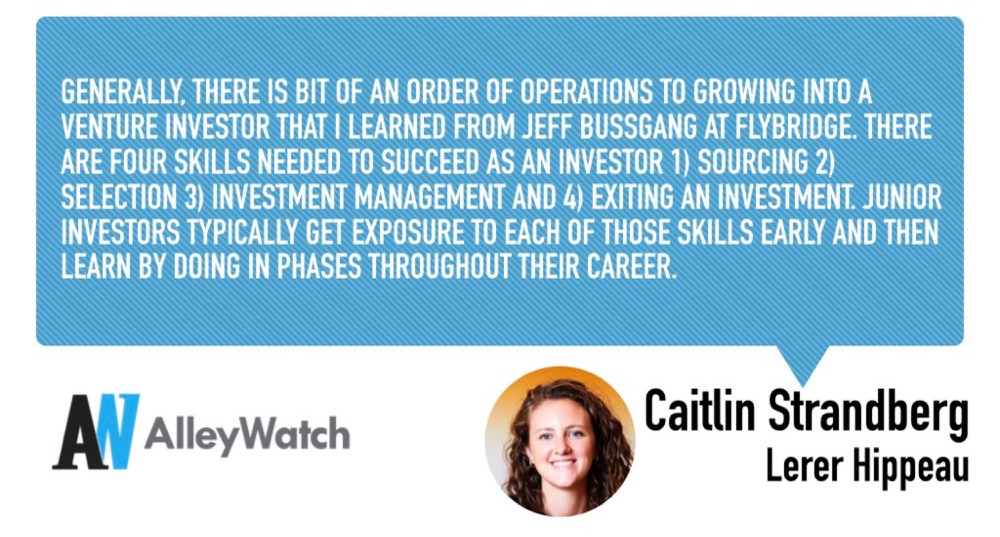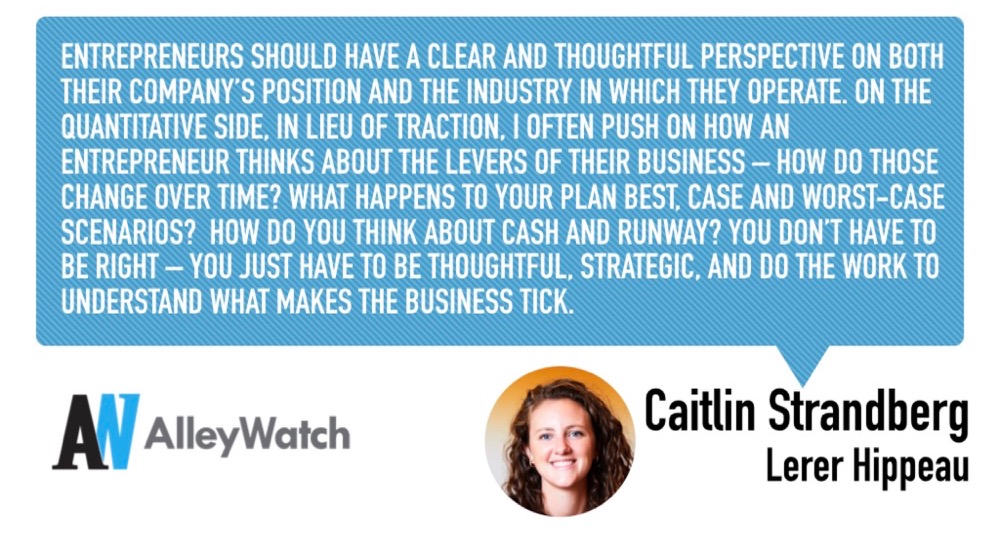Welcome back to Inside the Mind of an NYC VC, a highly acclaimed series at AlleyWatch in which we speak with New York City-based Venture Capitalists. In the hot seat this time is Caitlin Strandberg, Principal at Lerer Hippeau, the most active seed stage fund in NYC. Currently investing out of its sixth fund, which just closed in May at $122M, Lerer Hippeau has made over 250 investments in notable companies such as Venmo, Plated, Moat, Tapad, SeatGeek, and Warby Parker.
Caitlin joined us to discuss her path to venture after working as an early employee at two prominent NYC startups, the differences between the various roles found in venture, the many resources Lerer Hippeau offers entrepreneurs, actionable tips for entrepreneurs on how to handle the investor/entrepreneur relationship, and much, much more.
If you are a NYC-based VC interested in participating in this series, please send us an email. We’d love to chat. If you are interested in sponsoring this series that showcases the leading minds in venture in NYC, we’d also love to chat. Send us a note.
Reza Chowdhury, AlleyWatch: Please tell us a little bit about your background and how you started in venture.
Caitlin Strandberg, Lerer Hippeau: I started working in venture capital in 2012 after working as an early employee at two early-stage startups in New York City: LearnVest (acquired by Northwestern Mutual) and Behance (acquired by Adobe). In college, I cofounded a student-run digital media group (Internet radio, Internet TV, blog) and discovered my interest in entrepreneurship and wanted to learn from entrepreneurs I admired.
I remember when I first learned about venture capital. I was working at Behance and came across a profile of Christina Cacioppo, who was, at the time, an analyst at Union Square Ventures. That started off a bit of an internet rabbit-hole where I learned more about the day-to-day and thought – “hey, this sounds GREAT!”. I was already reading about different startups and founders in tech press and kind of connecting dots in my mind on trends and new spaces, so it felt like a natural fit.
At the time, I was focused on learning how to be a great entrepreneur, so when I found the right idea or cofounder, I’d feel ready to go! When Flybridge reached out to me a couple years later, I thought it was a great opportunity to learn the ropes of venture from both talented investors and wonderful people. I thought I’d be able to gain exposure to a wide range of different industries and see what success looked like in this space. It was an amazing experience and provided a great foundation for me to think about what I wanted to do professionally. I rolled into business school thinking I’d come out as a founder and after some reflection and self-discovery, I decided I wanted to continue down the investing path.
You’ve progressed through the venture capital ranks starting at as an Associate at Flybridge, then later a Senior Associate/ Vice President at Firstmark, and now as a Principal at Lerer Hippeau. How do these roles differ? How do these firms differ?
Every role at every firm is different! Generally, there is a bit of an order of operations to growing into a venture investor that I learned from Jeff Bussgang at Flybridge. There are four skills needed to succeed as an investor 1) sourcing 2) selection 3) investment management and 4) exiting an investment. Junior investors typically get exposure to each of those skills early and then learn by doing in phases throughout their career.
In the first phase, you’re trying to figure out if you can identify good opportunities to invest in – you learn how to be a filter for your firm. You ask yourself, “is this company in the firm’s wheelhouse? Can this founder communicate his or her vision effectively? Is this a compelling business in a compelling space?”. You go through trial and error for a little while and try to fine-tune your understanding of the landscape. This was a lot of the day-to-day at Flybridge – identifying great companies, either by network-driven sourcing or theme development – and developing a perspective on the opportunity. This tends to be the main activity for the analyst, associate, and senior associate type of role in venture. At Flybridge, my role was primarily sourcing, exposure to the investment decision process, and see different types of boards.
Once you’re able to effectively identify and source opportunities, selection is the next phase of development. If you’re seeing great deals, can you pick the best opportunities and take advantage of your access? I think of it as supplementing “gut feel” with a deeper thinking and analysis to gain confidence and conviction in a decision. Activities here tend to include varying levels of due diligence, assessing talent of the team and some sort of domain knowledge or insight on particular space. This often takes the form of creating supporting materials for a firm like investment memos or supporting analysis both for new companies as well as the firm’s existing portfolio. This type of work varies by fund but tends to be more representative in firms that have larger funds and make ~10-12 or fewer investments per year.
The third activity, managing your investment, is typically an activity for a principal as well as a partner-level investor. Once you’ve decided to make the investment, how do you support a company from a board perspective through team development, business strategy and relevant introductions? The principal role is about decision making and “owning” the deal internally. Ideally, you’re taking a board seat and practicing the skill of being a good board member, supporting the company through various challenges over time, all while continuing to look to make new investments and building your “track record.” At this stage, it’s typical for a partner or principal to work closely with an associate or an analyst to build out a case for an investment and ideally, that junior investor is able to gain exposure to the company board post-investment. As a principal at Lerer Hippeau, I’m in more of the driver’s seat in terms of sourcing, selecting, running a deal process and representing the firms as a board member. That said, I often do this with the help and support of the general partner on a deal.
The fourth activity is exiting an investment – the ultimate goal for an investor! This tends to be a partner-level activity supported by a junior investment team and activities include deal structuring, negotiating and orchestrating a process. Experience and exposure in this area is unique early in an investor’s career.
 You’ve been in the tech ecosystem since 2010. How has tech in NYC evolved since you started? Any observations – what do we do well and what do we need to improve on? Where are we as an ecosystem going forward from your vantage point?
You’ve been in the tech ecosystem since 2010. How has tech in NYC evolved since you started? Any observations – what do we do well and what do we need to improve on? Where are we as an ecosystem going forward from your vantage point?
There are all sorts of VC blog posts about the NYC Tech landscape so I won’t go into it more than to say, the ecosystem has grown considerably – more companies, more repeat founders, more exits at higher valuations, more anchor technology companies and more diversity in types of companies than ever before. It is an exciting and energizing time to be in NYC.
In terms of areas of improvement, I’d like to see the ecosystem support M&A activity across the spectrum. I think “landing” a company is both incredibly difficult and stressful – founders are essentially trying to raise another round of financing or sell the business at the same time. The venture community could do better to support both outcomes and make sure that founders/CEOs have the same access to information, introduction, and content that they do earlier in the company’s lifecycle. I see a lot of content around raising money but I see very little about selling the business. Building something of value is the goal.
Lerer Hippeau closed its sixth fund in May along with a Select fund. What can entrepreneurs expect with these two funds?
Our early stage fund is $122M, which gives us the opportunity to invest more capital at the first check. Our Select Fund is $60M, which allows us to participate in follow-on investments of our existing portfolio as well invest in later-stage companies. Both funds have allowed us to continue to build out the team on both the investment and platform side. I’m really excited about the development and expansion of our platform team and the work they’re doing – from portfolio collaboration and events, to setting up HR function and hiring plans, and ensuring our companies get the press and recognition necessary to build their business.
Is there a specific thesis that Lerer Hippeau employs to guide investments?
As a firm, we tend to be more generalist, but as a group of investors, we do have individual interests and sectors that excite us personally. On a whole, we’re looking for exceptional founders with some level of domain expertise, building a company that solves a real problem in a large and growing market, and where we can add unique value as firm. We focus on seed-level investments and while we invest globally, we are New York-first investors.
Lerer Hippeau has been the most active NYC investor in startups with over 250 portfolio companies. How many companies would you say you screen in a year? How do you manage this and what resources are in place to support your portfolio companies?
Collectively, the investment team looks at thousands of companies a year and in this latest fund, we’re targeting to do ~20 investments this year.
In terms of supporting our portfolio – that’s the work of our phenomenal platform team. They’ve done a great job of making a large portfolio feel intimate and accessible, in a way that the portfolio founders of some of our biggest companies give back to our newest portfolio founders. I’d describe our platform team as 1) having the right answer to any question 2) concierge service to finding the right resources to get your company from seed to Series A and 3) breaking down support into community, talent, and content strategy.
Lerer Hippeau has been popularly known as a consumer-focused fund although the actual portfolio widely varies. What are you excited about right now, from an investment standpoint? (less about individual companies, more about themes, industries, technologies, etc.)
While we’ve been fortunate to back some of the best new consumer brands, companies like Warby Parker, Casper, AllBirds and Glossier, we also have a strong track record on the enterprise side with businesses like Tapad, Moat, and Namely. The whole team is excited about emerging technologies and developing industries, some of our recent investments are in spaces around mobility, robotics, blockchain and cannabis. My interests dovetail with our existing portfolio but I’m also exploring themes around next-generation brands and retail, voice computing, and applications and innovations in healthcare.
What do you need to see from teams, both qualitatively and quantitatively, in order to invest?
Entrepreneurs should have a clear and thoughtful perspective on both their company’s position and the industry in which they operate. On the quantitative side, in lieu of traction, I often push on how an entrepreneur thinks about the levers of their business – how do those change over time? What happens to your plan best, case and worst-case scenarios? How do you think about cash and runway? You don’t have to be right – you just have to be thoughtful, strategic, and do the work to understand what makes the business tick.
What metrics do entrepreneurs overlook or not place enough emphasis on that are important to consider when you are evaluating investment merit of a business?
Metrics vary but if I had to pick a question that commonly has a wide-variance in the quality of response, I’d say go-to-market strategy. I often meet with founders that have a novel and compelling technology or IP but fall short on thinking through how to bring it to market and target potential customers.
What can entrepreneurs do to ensure that the funding process is smooth from first meeting to getting to a round close?
Fundraising is an incredibly time-consuming and exhausting time period for an entrepreneur. I recommend having materials ready to send if an investor asks for them – financial model, unit economic breakdown, references, expanded deck.
Maintaining momentum is important – being responsive to email asks, scheduling requests, and meeting follow-ups gets everyone to a decision faster.
What can entrepreneurs do to ensure that the relationship between the firm and companies is fruitful post investment?
Communicating regularly with your investors outside of board meetings, engaging in the firm’s platform, holding your investors accountable, and having specific asks for the firm (e.g. recruiting, introductions, example materials).
What are some things that you repeatedly see early stage companies and founders struggle with?
Hiring and recruiting tends to be the most requested resource from our portfolio founders, so much so that we hired a dedicated talent manager internally to help our companies think about HR planning and recruiting.
You co-authored a great guide on how to convey your business plan and vision during a meeting in the Entrepreneur’s Roadmap, which included some interesting ways that founders were able to demonstrate their products during meetings. What’s the most interesting and memorable thing that a founder has done to get on your radar for a meeting.
I’m pretty accessible so a good old-fashioned email typically does the trick and a warm introduction works best. Occasionally, I’ll need a “nudge” on an email – so don’t be afraid to follow-up. Outside of that, I don’t mind something atypical, just keep it professional.
Quick Hits:
Who do you admire in the startup world and why?
Creators and entrepreneurs everywhere: it takes an incredible amount of sacrifice, grit, and courage to will something into existence and convince others to join you. It reminds me of Teddy Roosevelt’s “Man in the Arena” speech.
What’s the last book you read?
I’m still not over Bad Blood: Secrets and Lies in a Silicon Valley Startup by John Carreyrou.
What’s your favorite restaurant in the city?
Maybe a Sunday night at Joseph Leonard’s or I’ll celebrate something at dell’Anima in the West Village. I recently moved to Manhattan from Williamsburg, so have some favorites there – I love sitting at the bar at The Four Horseman or drinks at my best kept secret, the Edda Bar at Aska.
What’s on your playlist right now that’s getting a lot of love?
I’m a former college radio DJ so I LOVE playlisting. I regularly update one of my public Spotify playlists with my latest favorites “Strandby’s Current Rotation.” For a real-time new music recommendations – I’m answering these questions while listening to Janelle Monae’s latest album, Dirty Computer and I’m getting a kick out of working out to the latest Chrvches album Love is Dead. I recently saw both acts live and loved both shows.
What’s your favorite outdoor activity in NYC?
If it’s warm, I like to hang out by the water. Otherwise, I’m a bit of a wanderer so I like to listen to music or talk on the phone while I go for walks and explore the city.






